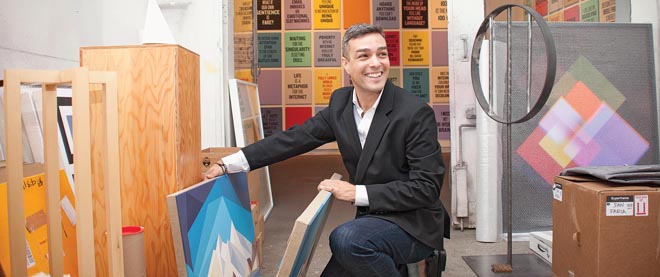Daniel Faria: the ambassador of cool
Toronto may be his home, but all the art world is Faria’s playground
Natalie Castellino
Share

It’s 6 p.m. on a Thursday night in September on a residential street in Toronto’s west end. The sound of clattering pots punctuates the air up and down the row of houses as families prepare for supper. But near the end of the street, in front of what used to be a mechanic’s garage, a motley crew of art groupies, design junkies and clued-in curators, collectors and critics is lining up outside the Daniel Faria Gallery to see works by Canadian mega-artist Douglas Coupland. The exhibition features 100 canvases the size of record albums carrying slogans such as “A fully linked world no longer needs a middle class.”
The owner, a 36-year-old dealer and gallerist, burst onto the scene when he opened the space last October, showing B.C.-born Shannon Bool, now based in Berlin, and then Toronto photographer Chris Curreri and his Mapplethorpe-ian collection of bodybuilder portraits. A recent New York Times story anointed Faria a “Toronto tastemaker,” which immediately filled his inbox with CVs from artists all over the world who wanted him to represent them.
“Some of my mornings are now consumed by clicking onto websites and opening jpegs from all these great talents,” says Faria, whose own resumé includes the Kitchener-Waterloo Art Gallery and a decade with Monte Clark in Toronto. “I feel like I have to go through them all so I don’t overlook anything exceptional that comes my way.”
His roster, which includes Hamilton filmmaker Mark Lewis, Canada’s representative at the 2009 Venice Biennale, benefits from Faria’s connections with international collectors. That’s why Douglas Coupland—who Faria credits for encouraging his entrepreneurship—signed on.
“I met Daniel 3,000 years ago when he was serving drinks at an art opening,” Coupland says over the phone from Vancouver. “I could tell back then that he was soaking in everything and figuring out how it all works. A good dealer needs to have specific skills—I think Daniel understands that 40 per cent of the job is matchmaking, finding the right artist for the right person. Another 40 per cent of it is about being institutionally engaged, 10 per cent of it is diplomacy,” Coupland says, pausing to relate how Faria delicately told him to revisit some of his pieces. “The other 10 per cent is important too. It’s about throwing really good exhibit openings. Luckily Dan’s hyper-social.”
Part of Faria’s allure—aside from his suave salt-and-pepper hair, tailored jackets and daytime-drama looks—is his social network. He proudly talks up friends as if they were clients: singing the praises of fashion designer Jeremy Laing and that of his former housemate, musician-singer Fritz Helder (who leads a Toronto-based electronic music quartet called Azari & III), as well the Canadian Opera Company and the Power Plant, two art institutions where he regularly serves on committees.
“This job is not about social climbing—it’s about building connections with other communities,” says Faria. “As a gallerist, I’m always trying to promote the business and the artists that I work with. The more people that I meet and who get to know me will come through to the gallery and then it becomes a really cool place. My primary goal is to work with artists that I completely believe in and promote their work to curators, sell their work to collectors, and be part of the process.” Another of Faria’s artists, New York-based painter Kristine Moran, insists there is more to him than hot type and cool guests.
“He’s ambitious and has made the art scene in Toronto cross over into other countries by putting himself out there,” says Moran, whose new solo show, Between Life and Death, opens Oct. 26. The Montreal-born artist says Faria’s presence at Miami Beach’s Art Basel and Germany’s Documenta has made him an ambassador for the Canadian art scene. “I can’t tell you how many times I meet artists from around New York or Europe who don’t know that he represents me, and they end up telling me about this Canadian guy they met at an art fair who impressed them . . . It always happens to be Daniel.”